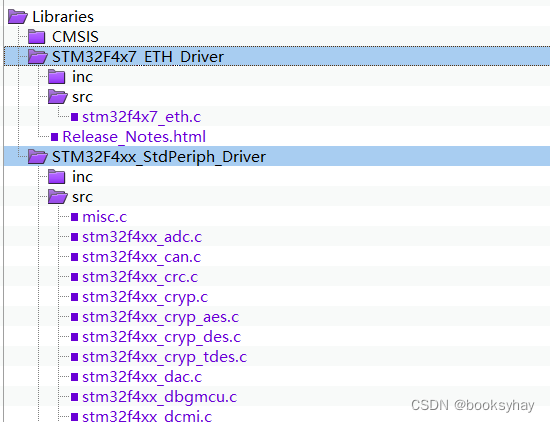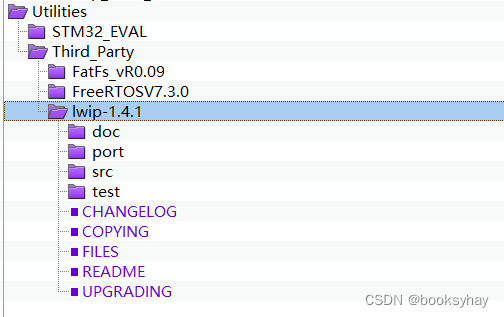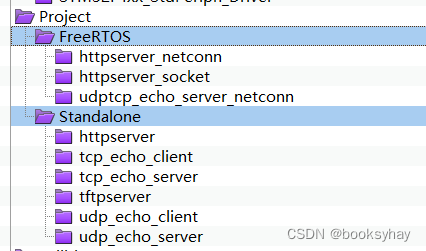项目背景
使用GD芯片的我们,都会去参考ST的代码。可是呢,有一个很大的问题就是,ST早就提供HAL库了,而目前GD还只有标准库。在移植LWIP的时候,会有很多不便。
好在天无绝人之路,找到了一份ST的官方例程,是使用标准库来移植LWIP的。
参考资料
AN3966-Application note-LwIP TCPIP stack demonstration for STM32F4x7 microcontrollers.pdf
附上链接:
an3966-lwip-tcpip-stack-demonstration-for-stm32f4x7-microcontrollers-stmicroelectronics.pdf
配套代码包:
代码结构
库代码
是标准库代码,版本V1.1.0,2013年的。

LWIP代码
版本是V1.4.1

例程代码
有两部分,无操作系统的,以及带FreeRTOS的。

关键代码
先解读不带OS的。
以 ...\Standalone\tcp_echo_server\工程为例。
关键代码分几个部分:
main()函数;
硬件外设配置;
lwip驱动;
应用层任务;
代码解读
main()函数
初始化
初始化部分,最主要的有3件事:
ETH_BSP_Config(); // 配置GPIO、时钟、MAC、DMA
LwIP_Init(); // 协议栈初始化
tcp_echoserver_init(); // 应用层任务初始化
主循环
主循环里的逻辑就很简单了,如果收到了以太网的报文,就处理数据包;
再调一个周期性的任务:LwIP_Periodic_Handle();
/**
* @brief Main program.
* @param None
* @retval None
*/
int main(void)
{
/*!< At this stage the microcontroller clock setting is already configured to
168 MHz, this is done through SystemInit() function which is called from
startup file (startup_stm32f4xx.s) before to branch to application main.
To reconfigure the default setting of SystemInit() function, refer to
system_stm32f4xx.c file
*/
NVIC_PriorityGroupConfig(NVIC_PriorityGroup_4);
#ifdef SERIAL_DEBUG
DebugComPort_Init();
#endif
/*Initialize LCD and Leds */
LCD_LED_Init();
/* configure ethernet (GPIOs, clocks, MAC, DMA) */
ETH_BSP_Config();
/* Initilaize the LwIP stack */
LwIP_Init();
/* tcp echo server Init */
tcp_echoserver_init();
/* Infinite loop */
while (1)
{
/* check if any packet received */
if (ETH_CheckFrameReceived())
{
/* process received ethernet packet*/
LwIP_Pkt_Handle();
}
/* handle periodic timers for LwIP*/
LwIP_Periodic_Handle(LocalTime);
}
}
外设配置
ETH_BSP_Config() -->ETH_GPIO_Config()
关键地方:配置MII模式还是RMII模式
/* MII/RMII Media interface selection --------------------------------------*/
#ifdef MII_MODE /* Mode MII with STM324xx-EVAL */
SYSCFG_ETH_MediaInterfaceConfig(SYSCFG_ETH_MediaInterface_MII);
#elif defined RMII_MODE /* Mode RMII with STM324xx-EVAL */
SYSCFG_ETH_MediaInterfaceConfig(SYSCFG_ETH_MediaInterface_RMII);
#endif
配置网络接口:最主要的就是以太网初始化ETH_Init();
/**
* @brief Configures the Ethernet Interface
* @param None
* @retval None
*/
static void ETH_MACDMA_Config(void)
{
/* Enable ETHERNET clock */
RCC_AHB1PeriphClockCmd(RCC_AHB1Periph_ETH_MAC | RCC_AHB1Periph_ETH_MAC_Tx |
RCC_AHB1Periph_ETH_MAC_Rx, ENABLE);
/* Reset ETHERNET on AHB Bus */
ETH_DeInit();
/* Software reset */
ETH_SoftwareReset();
/* Wait for software reset */
while (ETH_GetSoftwareResetStatus() == SET);
/* ETHERNET Configuration --------------------------------------------------*/
/* Call ETH_StructInit if you don't like to configure all ETH_InitStructure parameter */
ETH_StructInit(Ð_InitStructure);
/* Fill ETH_InitStructure parametrs */
/*------------------------ MAC -----------------------------------*/
ETH_InitStructure.ETH_AutoNegotiation = ETH_AutoNegotiation_Enable;
// ETH_InitStructure.ETH_AutoNegotiation = ETH_AutoNegotiation_Disable;
// ETH_InitStructure.ETH_Speed = ETH_Speed_10M;
// ETH_InitStructure.ETH_Mode = ETH_Mode_FullDuplex;
ETH_InitStructure.ETH_LoopbackMode = ETH_LoopbackMode_Disable;
ETH_InitStructure.ETH_RetryTransmission = ETH_RetryTransmission_Disable;
ETH_InitStructure.ETH_AutomaticPadCRCStrip = ETH_AutomaticPadCRCStrip_Disable;
ETH_InitStructure.ETH_ReceiveAll = ETH_ReceiveAll_Disable;
ETH_InitStructure.ETH_BroadcastFramesReception = ETH_BroadcastFramesReception_Enable;
ETH_InitStructure.ETH_PromiscuousMode = ETH_PromiscuousMode_Disable;
ETH_InitStructure.ETH_MulticastFramesFilter = ETH_MulticastFramesFilter_Perfect;
ETH_InitStructure.ETH_UnicastFramesFilter = ETH_UnicastFramesFilter_Perfect;
#ifdef CHECKSUM_BY_HARDWARE
ETH_InitStructure.ETH_ChecksumOffload = ETH_ChecksumOffload_Enable;
#endif
/*------------------------ DMA -----------------------------------*/
/* When we use the Checksum offload feature, we need to enable the Store and Forward mode:
the store and forward guarantee that a whole frame is stored in the FIFO, so the MAC can insert/verify the checksum,
if the checksum is OK the DMA can handle the frame otherwise the frame is dropped */
ETH_InitStructure.ETH_DropTCPIPChecksumErrorFrame = ETH_DropTCPIPChecksumErrorFrame_Enable;
ETH_InitStructure.ETH_ReceiveStoreForward = ETH_ReceiveStoreForward_Enable;
ETH_InitStructure.ETH_TransmitStoreForward = ETH_TransmitStoreForward_Enable;
ETH_InitStructure.ETH_ForwardErrorFrames = ETH_ForwardErrorFrames_Disable;
ETH_InitStructure.ETH_ForwardUndersizedGoodFrames = ETH_ForwardUndersizedGoodFrames_Disable;
ETH_InitStructure.ETH_SecondFrameOperate = ETH_SecondFrameOperate_Enable;
ETH_InitStructure.ETH_AddressAlignedBeats = ETH_AddressAlignedBeats_Enable;
ETH_InitStructure.ETH_FixedBurst = ETH_FixedBurst_Enable;
ETH_InitStructure.ETH_RxDMABurstLength = ETH_RxDMABurstLength_32Beat;
ETH_InitStructure.ETH_TxDMABurstLength = ETH_TxDMABurstLength_32Beat;
ETH_InitStructure.ETH_DMAArbitration = ETH_DMAArbitration_RoundRobin_RxTx_2_1;
/* Configure Ethernet */
EthStatus = ETH_Init(Ð_InitStructure, DP83848_PHY_ADDRESS);
}
协议栈初始化
LwIP_Init()函数,在netconf.c文件里。
删除DHCP和LCD显示后的LwIP_Init()函数代码如下:
/**
* @brief Initializes the lwIP stack
* @param None
* @retval None
*/
void LwIP_Init(void)
{
struct ip_addr ipaddr;
struct ip_addr netmask;
struct ip_addr gw;
/* Initializes the dynamic memory heap defined by MEM_SIZE.*/
mem_init();
/* Initializes the memory pools defined by MEMP_NUM_x.*/
memp_init();
IP4_ADDR(&ipaddr, IP_ADDR0, IP_ADDR1, IP_ADDR2, IP_ADDR3);
IP4_ADDR(&netmask, NETMASK_ADDR0, NETMASK_ADDR1 , NETMASK_ADDR2, NETMASK_ADDR3);
IP4_ADDR(&gw, GW_ADDR0, GW_ADDR1, GW_ADDR2, GW_ADDR3);
/* - netif_add(struct netif *netif, struct ip_addr *ipaddr,
struct ip_addr *netmask, struct ip_addr *gw,
void *state, err_t (* init)(struct netif *netif),
err_t (* input)(struct pbuf *p, struct netif *netif))
Adds your network interface to the netif_list. Allocate a struct
netif and pass a pointer to this structure as the first argument.
Give pointers to cleared ip_addr structures when using DHCP,
or fill them with sane numbers otherwise. The state pointer may be NULL.
The init function pointer must point to a initialization function for
your ethernet netif interface. The following code illustrates it's use.*/
netif_add(&gnetif, &ipaddr, &netmask, &gw, NULL, ðernetif_init, ðernet_input);
/* Registers the default network interface.*/
netif_set_default(&gnetif);
if (EthStatus == (ETH_INIT_FLAG | ETH_LINK_FLAG))
{
/* Set Ethernet link flag */
gnetif.flags |= NETIF_FLAG_LINK_UP;
/* When the netif is fully configured this function must be called.*/
netif_set_up(&gnetif);
}
else
{
/* When the netif link is down this function must be called.*/
netif_set_down(&gnetif);
/* Set the link callback function, this function is called on change of link status*/
netif_set_link_callback(&gnetif, ETH_link_callback);
}主要的有几点:设置IP地址;添加网卡;设置网卡工作起来;
lwip驱动
最关键的是ethernetif.c
位置在:
STSW_STM32070_LwIP_TCP_IP_STM32F4x7堆栈示例\STM32F4x7_ETH_LwIP_V1.1.1\Utilities\Third_Party\lwip-1.4.1\port\STM32F4x7\Standalone\ethernetif.c
针对网卡netif的接口函数:
网卡初始化ethernetif_init
关键点:
设置 linkoutput = low_level_output;
调用 low_level_init();
err_t ethernetif_init(struct netif *netif)
{
LWIP_ASSERT("netif != NULL", (netif != NULL));
#if LWIP_NETIF_HOSTNAME
/* Initialize interface hostname */
netif->hostname = "lwip";
#endif /* LWIP_NETIF_HOSTNAME */
netif->name[0] = IFNAME0;
netif->name[1] = IFNAME1;
/* We directly use etharp_output() here to save a function call.
* You can instead declare your own function an call etharp_output()
* from it if you have to do some checks before sending (e.g. if link
* is available...) */
netif->output = etharp_output;
netif->linkoutput = low_level_output;
/* initialize the hardware */
low_level_init(netif);
return ERR_OK;
}底层初始化low_level_init
主要是调用外设库函数,配置DMA描述符,然后启动ETH。
/**
* In this function, the hardware should be initialized.
* Called from ethernetif_init().
*
* @param netif the already initialized lwip network interface structure
* for this ethernetif
*/
static void low_level_init(struct netif *netif)
{
#ifdef CHECKSUM_BY_HARDWARE
int i;
#endif
/* set MAC hardware address length */
netif->hwaddr_len = ETHARP_HWADDR_LEN;
/* set MAC hardware address */
netif->hwaddr[0] = MAC_ADDR0;
netif->hwaddr[1] = MAC_ADDR1;
netif->hwaddr[2] = MAC_ADDR2;
netif->hwaddr[3] = MAC_ADDR3;
netif->hwaddr[4] = MAC_ADDR4;
netif->hwaddr[5] = MAC_ADDR5;
/* initialize MAC address in ethernet MAC */
ETH_MACAddressConfig(ETH_MAC_Address0, netif->hwaddr);
/* maximum transfer unit */
netif->mtu = 1500;
/* device capabilities */
/* don't set NETIF_FLAG_ETHARP if this device is not an ethernet one */
netif->flags = NETIF_FLAG_BROADCAST | NETIF_FLAG_ETHARP;
/* Initialize Tx Descriptors list: Chain Mode */
ETH_DMATxDescChainInit(DMATxDscrTab, &Tx_Buff[0][0], ETH_TXBUFNB);
/* Initialize Rx Descriptors list: Chain Mode */
ETH_DMARxDescChainInit(DMARxDscrTab, &Rx_Buff[0][0], ETH_RXBUFNB);
#ifdef CHECKSUM_BY_HARDWARE
/* Enable the TCP, UDP and ICMP checksum insertion for the Tx frames */
for(i=0; i<ETH_TXBUFNB; i++)
{
ETH_DMATxDescChecksumInsertionConfig(&DMATxDscrTab[i], ETH_DMATxDesc_ChecksumTCPUDPICMPFull);
}
#endif
/* Note: TCP, UDP, ICMP checksum checking for received frame are enabled in DMA config */
/* Enable MAC and DMA transmission and reception */
ETH_Start();
}
网卡输入ethernetif_input
调用low_level_input(),获取输入数据,再调用netif->input()由协议栈处理。
/**
* This function should be called when a packet is ready to be read
* from the interface. It uses the function low_level_input() that
* should handle the actual reception of bytes from the network
* interface. Then the type of the received packet is determined and
* the appropriate input function is called.
*
* @param netif the lwip network interface structure for this ethernetif
*/
err_t ethernetif_input(struct netif *netif)
{
err_t err;
struct pbuf *p;
/* move received packet into a new pbuf */
p = low_level_input(netif);
/* no packet could be read, silently ignore this */
if (p == NULL) return ERR_MEM;
/* entry point to the LwIP stack */
err = netif->input(p, netif);
if (err != ERR_OK)
{
LWIP_DEBUGF(NETIF_DEBUG, ("ethernetif_input: IP input error\n"));
pbuf_free(p);
}
return err;
}
底层输入low_level_input
从外设库函数获取数据大小及内容,拷贝到lwip分配的pbuf中。
/**
* Should allocate a pbuf and transfer the bytes of the incoming
* packet from the interface into the pbuf.
*
* @param netif the lwip network interface structure for this ethernetif
* @return a pbuf filled with the received packet (including MAC header)
* NULL on memory error
*/
static struct pbuf * low_level_input(struct netif *netif)
{
struct pbuf *p, *q;
uint32_t len;
FrameTypeDef frame;
u8 *buffer;
__IO ETH_DMADESCTypeDef *DMARxDesc;
uint32_t bufferoffset = 0;
uint32_t payloadoffset = 0;
uint32_t byteslefttocopy = 0;
uint32_t i=0;
/* get received frame */
frame = ETH_Get_Received_Frame();
/* Obtain the size of the packet and put it into the "len" variable. */
len = frame.length;
buffer = (u8 *)frame.buffer;
/* We allocate a pbuf chain of pbufs from the Lwip buffer pool */
p = pbuf_alloc(PBUF_RAW, len, PBUF_POOL);
if (p != NULL)
{
DMARxDesc = frame.descriptor;
bufferoffset = 0;
for(q = p; q != NULL; q = q->next)
{
byteslefttocopy = q->len;
payloadoffset = 0;
/* Check if the length of bytes to copy in current pbuf is bigger than Rx buffer size*/
while( (byteslefttocopy + bufferoffset) > ETH_RX_BUF_SIZE )
{
/* Copy data to pbuf*/
memcpy( (u8_t*)((u8_t*)q->payload + payloadoffset), (u8_t*)((u8_t*)buffer + bufferoffset), (ETH_RX_BUF_SIZE - bufferoffset));
/* Point to next descriptor */
DMARxDesc = (ETH_DMADESCTypeDef *)(DMARxDesc->Buffer2NextDescAddr);
buffer = (unsigned char *)(DMARxDesc->Buffer1Addr);
byteslefttocopy = byteslefttocopy - (ETH_RX_BUF_SIZE - bufferoffset);
payloadoffset = payloadoffset + (ETH_RX_BUF_SIZE - bufferoffset);
bufferoffset = 0;
}
/* Copy remaining data in pbuf */
memcpy( (u8_t*)((u8_t*)q->payload + payloadoffset), (u8_t*)((u8_t*)buffer + bufferoffset), byteslefttocopy);
bufferoffset = bufferoffset + byteslefttocopy;
}
}
/* Release descriptors to DMA */
DMARxDesc =frame.descriptor;
/* Set Own bit in Rx descriptors: gives the buffers back to DMA */
for (i=0; i<DMA_RX_FRAME_infos->Seg_Count; i++)
{
DMARxDesc->Status = ETH_DMARxDesc_OWN;
DMARxDesc = (ETH_DMADESCTypeDef *)(DMARxDesc->Buffer2NextDescAddr);
}
/* Clear Segment_Count */
DMA_RX_FRAME_infos->Seg_Count =0;
/* When Rx Buffer unavailable flag is set: clear it and resume reception */
if ((ETH->DMASR & ETH_DMASR_RBUS) != (u32)RESET)
{
/* Clear RBUS ETHERNET DMA flag */
ETH->DMASR = ETH_DMASR_RBUS;
/* Resume DMA reception */
ETH->DMARPDR = 0;
}
return p;
}
底层输出low_level_output
将pbuf的内容交给外设库发送出去。
/**
* This function should do the actual transmission of the packet. The packet is
* contained in the pbuf that is passed to the function. This pbuf
* might be chained.
*
* @param netif the lwip network interface structure for this ethernetif
* @param p the MAC packet to send (e.g. IP packet including MAC addresses and type)
* @return ERR_OK if the packet could be sent
* an err_t value if the packet couldn't be sent
*
* @note Returning ERR_MEM here if a DMA queue of your MAC is full can lead to
* strange results. You might consider waiting for space in the DMA queue
* to become availale since the stack doesn't retry to send a packet
* dropped because of memory failure (except for the TCP timers).
*/
static err_t low_level_output(struct netif *netif, struct pbuf *p)
{
err_t errval;
struct pbuf *q;
u8 *buffer = (u8 *)(DMATxDescToSet->Buffer1Addr);
__IO ETH_DMADESCTypeDef *DmaTxDesc;
uint16_t framelength = 0;
uint32_t bufferoffset = 0;
uint32_t byteslefttocopy = 0;
uint32_t payloadoffset = 0;
DmaTxDesc = DMATxDescToSet;
bufferoffset = 0;
/* copy frame from pbufs to driver buffers */
for(q = p; q != NULL; q = q->next)
{
/* Is this buffer available? If not, goto error */
if((DmaTxDesc->Status & ETH_DMATxDesc_OWN) != (u32)RESET)
{
errval = ERR_BUF;
goto error;
}
/* Get bytes in current lwIP buffer */
byteslefttocopy = q->len;
payloadoffset = 0;
/* Check if the length of data to copy is bigger than Tx buffer size*/
while( (byteslefttocopy + bufferoffset) > ETH_TX_BUF_SIZE )
{
/* Copy data to Tx buffer*/
memcpy( (u8_t*)((u8_t*)buffer + bufferoffset), (u8_t*)((u8_t*)q->payload + payloadoffset), (ETH_TX_BUF_SIZE - bufferoffset) );
/* Point to next descriptor */
DmaTxDesc = (ETH_DMADESCTypeDef *)(DmaTxDesc->Buffer2NextDescAddr);
/* Check if the buffer is available */
if((DmaTxDesc->Status & ETH_DMATxDesc_OWN) != (u32)RESET)
{
errval = ERR_USE;
goto error;
}
buffer = (u8 *)(DmaTxDesc->Buffer1Addr);
byteslefttocopy = byteslefttocopy - (ETH_TX_BUF_SIZE - bufferoffset);
payloadoffset = payloadoffset + (ETH_TX_BUF_SIZE - bufferoffset);
framelength = framelength + (ETH_TX_BUF_SIZE - bufferoffset);
bufferoffset = 0;
}
/* Copy the remaining bytes */
memcpy( (u8_t*)((u8_t*)buffer + bufferoffset), (u8_t*)((u8_t*)q->payload + payloadoffset), byteslefttocopy );
bufferoffset = bufferoffset + byteslefttocopy;
framelength = framelength + byteslefttocopy;
}
/* Note: padding and CRC for transmitted frame
are automatically inserted by DMA */
/* Prepare transmit descriptors to give to DMA*/
ETH_Prepare_Transmit_Descriptors(framelength);
errval = ERR_OK;
error:
/* When Transmit Underflow flag is set, clear it and issue a Transmit Poll Demand to resume transmission */
if ((ETH->DMASR & ETH_DMASR_TUS) != (uint32_t)RESET)
{
/* Clear TUS ETHERNET DMA flag */
ETH->DMASR = ETH_DMASR_TUS;
/* Resume DMA transmission*/
ETH->DMATPDR = 0;
}
return errval;
}
主循环任务
数据包处理
收到数据包后,直接交给ethernetif_input()处理。
/**
* @brief Called when a frame is received
* @param None
* @retval None
*/
void LwIP_Pkt_Handle(void)
{
/* Read a received packet from the Ethernet buffers and send it to the lwIP for handling */
ethernetif_input(&gnetif);
}
周期任务
主要是处理时间相关的内容。
/**
* @brief LwIP periodic tasks
* @param localtime the current LocalTime value
* @retval None
*/
void LwIP_Periodic_Handle(__IO uint32_t localtime)
{
#if LWIP_TCP
/* TCP periodic process every 250 ms */
if (localtime - TCPTimer >= TCP_TMR_INTERVAL)
{
TCPTimer = localtime;
tcp_tmr();
}
#endif
/* ARP periodic process every 5s */
if ((localtime - ARPTimer) >= ARP_TMR_INTERVAL)
{
ARPTimer = localtime;
etharp_tmr();
}
}